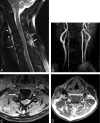Incidence of vertebral artery thrombosis in cervical spine trauma: correlation with severity of spinal cord injury
- PMID: 16286417
- PMCID: PMC7976210
Incidence of vertebral artery thrombosis in cervical spine trauma: correlation with severity of spinal cord injury
Abstract
Background and purpose: The incidence of blunt traumatic vertebral artery dissection/thrombosis varies widely in published trauma series and is associated with spinal trauma. The purpose of this study was to determine the frequency of traumatic vertebral artery thrombosis (VAT) in cervically injured patients by using routine MR angiography (MRA) and MR imaging and identify associations with the severity of neurologic injury.
Methods: A retrospective review of 1283 patients with nonpenetrating cervical spine fractures with or without an associated spinal cord injury (SCI) was performed. Imaging consisted of routine cervical MR imaging and 2D time-of-flight MRA of the neck. The cervical injury level, neurologic level of injury, and American Spinal Injury Association (ASIA) grade were recorded.
Results: In this study, 632 patients met the inclusion criteria, 83 (13%) of whom had VAT on the admission MR imaging/MRA. Fifty-nine percent (49/83) of VAT patients had an associated SCI. VAT was significantly more common in motor-complete patients (ASIA A and B, 20%) than in neurologically intact (ASIA E, 11%) cervical spine-injured patients (P = .019). VAT incidence was not significantly different between motor-incomplete (ASIA C and D, 10%) and neurologically intact (ASIA E, 11%) cervical spine-injured patients (P = .840).
Conclusion: The absence of neurologic symptoms in a patient with cervical spine fracture does not preclude VAT. VAT associated with cervical spinal injury occurs with similar frequency in both neurologically intact (ASIA E) and motor-incomplete patients (ASIA C and D) but is significantly more common in motor-complete SCI (ASIA A and B).
Figures

References
-
- Parbhoo AH, Govender S, Corr P. Vertebral artery injury in cervical spine trauma. Injury Int J Care Injured 2001;32:565–568 - PubMed
-
- Louw JA, Mafoyane NA, Small B, Neser CP. Occlusion of the vertebral artery in cervical spine dislocations. J Bone Joint Surg [Br]1990;72:679–681 - PubMed
-
- Weller SJ, Rosstich E, Malek AM. Detection of vertebral artery injury after cervical spine trauma using magnetic resonance angiography. J Trauma 1999;46:660–666 - PubMed
-
- Willis BK, Greiner F, Orrison WW, Benzel EC. The incidence of vertebral artery injury after midcervical spine fracture or subluxation. Neurosurgery 1994;34:435–442 - PubMed
Publication types
MeSH terms
LinkOut - more resources
Full Text Sources
Medical
Miscellaneous
